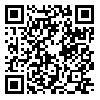Volume 1, Issue 1 (2014)
QHTS 2014, 1(1): 115-146 |
Back to browse issues page
Download citation:
BibTeX | RIS | EndNote | Medlars | ProCite | Reference Manager | RefWorks
Send citation to:



BibTeX | RIS | EndNote | Medlars | ProCite | Reference Manager | RefWorks
Send citation to:
Mostafavi-nia S M R. The Criticism of Translation Structure of Independent (fasl) pronoun: A Case of Safarzadeh and Hadad Adel. QHTS 2014; 1 (1) :115-146
URL: http://qhts.modares.ac.ir/article-10-9801-en.html
URL: http://qhts.modares.ac.ir/article-10-9801-en.html
Assistant Prof. of Criticism and Translation, University of Qum, Iran
Abstract: (14881 Views)
Undoubtedly, understanding the Holy Qur'an and representing lingual concepts and innovation may be difficult. Thus, it is vital that the translator is proficient in the Qur'anic language. The Holy Qur'an is extremely eloquent and rhetoric literally, and there exists so beautiful styles and formats within it such as independent pronouns. Given that “independent pronoun” is important in transferring the meaning, the present study seeks to its semantic aspects in Hadad Adel’s and Safarzadeh's translations of the Holy Qur'an. The author first defines “independent pronoun”, and then studies different translations of the Holy Qur'an. Next, the proposed translations are recited. In the process of studying and criticizing Hadad Adel’s and Safarzadeh's translations, it became evident that these translations do not follow the same method in translating “independent pronouns”; for example, the pronouns in similar situation are translated differently, and sometimes the translators apply translation. Also some translations do not represent “independent pronoun”, and it has not been translated in some cases. Finally, the frequency of equivalents of “independent pronouns” in translations has been presented comparatively in a graph.
Received: 2014/08/16 | Accepted: 2015/01/21 | Published: 2015/02/10
| Rights and permissions | |
 |
This work is licensed under a Creative Commons Attribution-NonCommercial 4.0 International License. |








